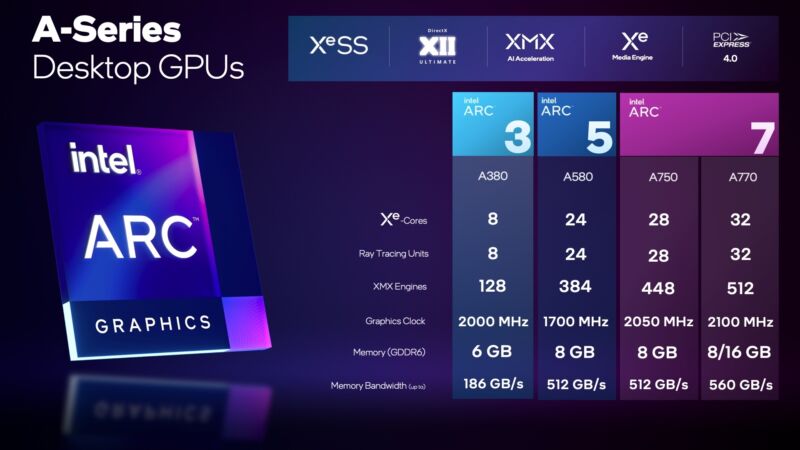

Do Intel’s new graphics drivers actually overclock its low-end GPUs?
source link: https://arstechnica.com/gadgets/2023/08/no-intel-isnt-overclocking-arc-graphics-cards-with-a-driver-update/
Go to the source link to view the article. You can view the picture content, updated content and better typesetting reading experience. If the link is broken, please click the button below to view the snapshot at that time.

bursting bubbles —
Do Intel’s new graphics drivers actually overclock its low-end GPUs?
Higher reported clock speed for Arc A380 doesn't actually increase performance.
Andrew Cunningham - 8/22/2023, 3:43 PM

When we write about Intel's Arc GPUs, we're typically paying the most attention to the A750 and A770 because they're the cards that perform well enough that you might actually put them in an entry-level-to-midrange gaming desktop. But there's one other Arc graphics card of note: the lowly Arc A380, which snuck into some stores a few months before either high-end Arc card was released.
With its eight Xe cores (down from 32 in the A770), 96-bit memory interface, and 6GB of RAM, the Arc A380 has been (in my case, literally) nothing to write home about. It's an entry-level graphics card that competes reasonably well with ancient and low-end cards like Nvidia's GeForce RTX 1650 and AMD's Radeon RX 6400, and its hardware-accelerated AV1 video encoding support makes it mildly interesting for people who work with video. It's one of the better GPUs you can get for $100, its current street price, but that's not saying much.
-
Pre-firmware update, HWInfo reports the clock speed at 2,000 MHz.
-
Post-update, the clock speed is listed at 2,150 MHz.
But Intel's latest graphics drivers provided an update specifically for the A380 that seems notable because of how rare it is: the 31.0.101.4644 driver package released last week also includes a firmware update for A380 cards that seems to boost their base clock speed from 2,000 MHz up to 2,150 MHz. That's a 7.5 percent increase, supposedly being provided for free to all A380 owners with a simple firmware update. At least, it would be if it were an actual increase in the card's peak clock speed, which it isn't.
Advertisement
We have an ASRock Challenger ITX version of the A380, a card we bought back in the early days of Arc to track the progress of Intel's buggy drivers (it informed our original review of the A750 and A770). I can confirm firsthand that the new driver package does update the GPU's firmware, and reporting tools like GPU-Z and HWInfo did indeed report a clock speed increase from 2,000 to 2,150 MHz. But that number doesn't represent the real peak clock speed of the Arc A380, and in the tests we ran, we noticed no statistically significant difference in performance.
Intel's own Arc spec sheet lists the graphics clock of the A380 at 2,000 MHz, but in Intel's own words, this number "represents the average clock an end user may see in a typical gaming workload," not the maximum clock speed at which the card can run. For the Arc A380, this maximum clock speed (both before and after the firmware update) was actually 2,450 MHz, and the A380 runs cool enough and uses little enough power that the GPU never throttled its speeds throughout multiple benchmark runs. That 2,450 MHz clock speed is also the one used by the GUNNIR-branded Arc A380 card that many early reviewers tested, as well as every Arc A380 result I checked in the Geekbench results database; in other words, this configuration seems to be the norm for A380 GPUs and not an exotic card-specific overclock.
Advertisement
To double-check our work, we also turned Intel's opaque Arc overclocking slider in the Arc Control app up to 25, which raised the A380's maximum reported clock speed up to 2,528 MHz, a roughly 3 percent increase. This relatively mild overclock improved our benchmark scores by... 2 or 3 percent. If the firmware-provided "overclock" had actually improved performance, the tests we've run would have picked up on it.
-
If your card can have its firmware updated, the GPU driver installer will tell you so.
-
The firmware installation screen.
Intel confirmed to Ars that the clock speed change was not intended to change the A380's performance, and it shouldn't be seen as an "overclock."
"In a recent driver update, we changed the reported graphics clock of the A380," an Intel spokesperson told Ars. "Actual performance and frequency were not affected and we are working on an update to revert the change in a future driver update."
So what does this firmware update do? It's not mentioned in the release notes, but Intel told Neowin last week that it "brings stability improvements, better fan behavior, bug fixes, and better compatibility with HDMI connections."
Even if you can't get a free clock speed boost from a firmware update, it's worth it to make sure your Arc drivers are up to date. The Arc A380 will benefit to some extent from the same "rearchitected" DirectX 9 and DirectX 11 drivers, Arc Control app updates, and other fixes that Intel has released for all Arc cards, substantially addressing most of our biggest concerns about the early drivers.
Listing image by Intel/Andrew Cunningham
Recommend
About Joyk
Aggregate valuable and interesting links.
Joyk means Joy of geeK